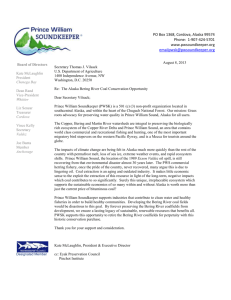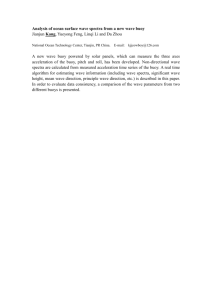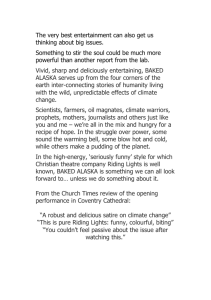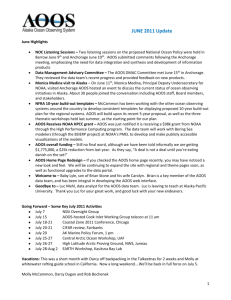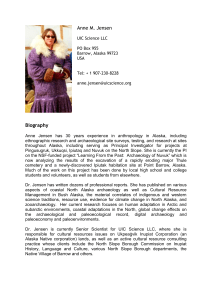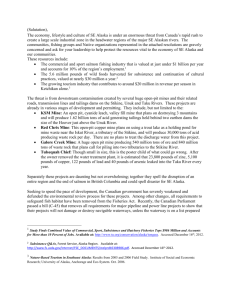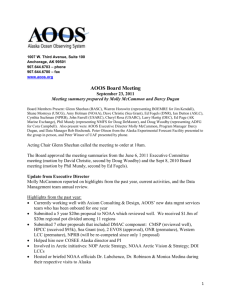AOOS Part 1 Marine Operations
advertisement
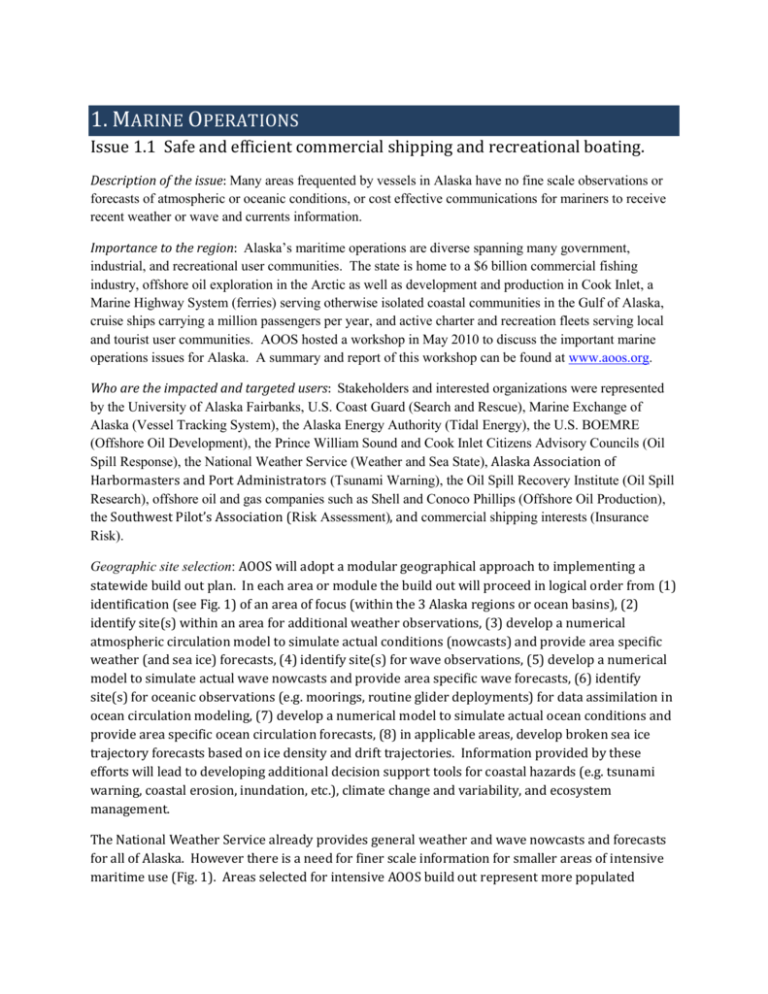
1. MARINE OPERATIONS Issue 1.1 Safe and efficient commercial shipping and recreational boating. Description of the issue: Many areas frequented by vessels in Alaska have no fine scale observations or forecasts of atmospheric or oceanic conditions, or cost effective communications for mariners to receive recent weather or wave and currents information. Importance to the region: Alaska’s maritime operations are diverse spanning many government, industrial, and recreational user communities. The state is home to a $6 billion commercial fishing industry, offshore oil exploration in the Arctic as well as development and production in Cook Inlet, a Marine Highway System (ferries) serving otherwise isolated coastal communities in the Gulf of Alaska, cruise ships carrying a million passengers per year, and active charter and recreation fleets serving local and tourist user communities. AOOS hosted a workshop in May 2010 to discuss the important marine operations issues for Alaska. A summary and report of this workshop can be found at www.aoos.org. Who are the impacted and targeted users: Stakeholders and interested organizations were represented by the University of Alaska Fairbanks, U.S. Coast Guard (Search and Rescue), Marine Exchange of Alaska (Vessel Tracking System), the Alaska Energy Authority (Tidal Energy), the U.S. BOEMRE (Offshore Oil Development), the Prince William Sound and Cook Inlet Citizens Advisory Councils (Oil Spill Response), the National Weather Service (Weather and Sea State), Alaska Association of Harbormasters and Port Administrators (Tsunami Warning), the Oil Spill Recovery Institute (Oil Spill Research), offshore oil and gas companies such as Shell and Conoco Phillips (Offshore Oil Production), the Southwest Pilot’s Association (Risk Assessment), and commercial shipping interests (Insurance Risk). Geographic site selection: AOOS will adopt a modular geographical approach to implementing a statewide build out plan. In each area or module the build out will proceed in logical order from (1) identification (see Fig. 1) of an area of focus (within the 3 Alaska regions or ocean basins), (2) identify site(s) within an area for additional weather observations, (3) develop a numerical atmospheric circulation model to simulate actual conditions (nowcasts) and provide area specific weather (and sea ice) forecasts, (4) identify site(s) for wave observations, (5) develop a numerical model to simulate actual wave nowcasts and provide area specific wave forecasts, (6) identify site(s) for oceanic observations (e.g. moorings, routine glider deployments) for data assimilation in ocean circulation modeling, (7) develop a numerical model to simulate actual ocean conditions and provide area specific ocean circulation forecasts, (8) in applicable areas, develop broken sea ice trajectory forecasts based on ice density and drift trajectories. Information provided by these efforts will lead to developing additional decision support tools for coastal hazards (e.g. tsunami warning, coastal erosion, inundation, etc.), climate change and variability, and ecosystem management. The National Weather Service already provides general weather and wave nowcasts and forecasts for all of Alaska. However there is a need for finer scale information for smaller areas of intensive maritime use (Fig. 1). Areas selected for intensive AOOS build out represent more populated embayments and coastlines. The area enclosed by the boxes are sized, based on lessons learned in Prince William Sound, to be tractable for the deployment of atmospheric and oceanic instrumentation packages and for the development of higher resolution model domains. Figure 1. Areas of proposed intensive observing system development within each of the Alaska regions: in the Gulf of Alaska: (1) Southeast, (2) Prince William Sound, (3) Cook Inlet, (4) Kodiak, (5) Unimak Pass; in the Bering Sea: (6) Adak/Western Aleutians, (7) Bristol Bay, (8) Norton Sound; (9) the Bering Strait; and in the Arctic Ocean: (10) Kotzebue Sound, (11) Chukchi Sea, (12) Beaufort Sea. The AOOS advisory committees and Board will identify and select (respectively) successive or simultaneous build out areas based on annual budget allocations and stakeholder prioritization. A general strategy for the build out of AOOS is shown in Figure 2, where weather simulations are first developed based on weather observations, then ocean models are based on ocean observations and weather forecasts, etc.. Every phase of development must have a communication strategy so that all the observations are accessible to the computers running the models and to the public from the AOOS web site. Figure 2. General strategy of the AOOS build out. 1.1.1 PRODUCT AND SERVICES: Weather and sea state conditions for mariners First, site specific weather conditions (see accompanying table) will utilize a low cost meteorological sensor array to collect key IOOS atmospheric variables. This array may be similar to the standardized weather stations used by the NOAA NERRS in the System Wide Monitoring program or the experimental array at Cape St. Elias (http://denali.micro-specialties.com/CapeStElias/CSE%20Metadata.htm). The design will include, at a minimum, wind speed and direction, air temperature, and barometric pressure. Some installations with immediate access to sufficient power supplies and internet bandwidth may be augmented with webcams for qualitative sea state and ice observations. Next, once the weather stations are deployed, numerical models are developed to simulate area-wide synoptic weather conditions. AOOS has taken a lead role in developing collaborations with the University of Alaska Anchorage and Fairbanks campuses to develop Weather Research Forecasting (WRF) atmospheric circulation models that now provide statewide, regional (e.g. GOA, Bering), and area scale (e.g. Prince William Sound and Cook Inlet) nowcasts/forecasts. There is an on-going effort to integrate the nowcasts/forecasts with the National Weather Service regional forecasts. The WRF nowcasts and forecasts are disseminated through the AOOS Model Explorer (www.aoos.org). The wind nowcast/forecasts are used directly and also as input to area-scale synoptic wave and ocean circulation models. The performance of wind nowcasts/forecasts are evaluated by site-scale weather observations and subsequently inform wave and ocean circulation models. Site specific sea state conditions are observed with wave buoys. AOOS collaborated with the NDBC, Scripps, and the US Army Corp of Engineers in 2011 to deploy the first CDIP wave buoy in Alaska as part of an expanding effort to provide observations of sea state to mariners. This buoy is providing measurements of wave height, period, and direction to aid in validating a synoptic wave model for Cook Inlet. This wave buoy is intended as a demonstration of the technology in Alaska and if successful will be used in other areas around the state. Synoptic sea state conditions are obtained using wave models linked to the AOOS wind nowcast/forecast models and wave buoy observations. In the near term AOOS will continue collaborating with Texas A&M University on developing a Simulating Waves in the Nearshore (SWAN) wave model domains for PWS and Cook Inlet. In the longer, term, to economize the modeling effort, AOOS may seek a contract for a coupled approach with the wave modeling conducted in tandem with the atmospheric modeling from one location. INFORMATION REQUIREMENTS (WEATHER AND SEA STATE): Regions Geographic Focus Areas Gulf of Alaska Cross Sound/Icy Strait 1 Prince William Sound 2 Cook Inlet 3 Kodiak 4 Alaska Peninsula 5 Bering Sea Bristol Bay 6 Adak 7 Norton Sound 8 Bering Strait 9 Arctic Ocean Kotzebue Sound 10 Chukchi Sea 11 Beaufort Sea 12 * minimum or 3 sites (TBD)/area Platform Land Land Land Land Model Buoy Buoy Buoy Buoy Model Observations and models Parameters Time step Resolution Spatial* Wind speed Wind direction Temperature air Pressure air Weather Nowcast/Forecast Wave height Wave period Wave direction Water temperature Wave Nowcast/Forecast 15 min 15 min 15 min 15 min 1hr/6hr 15 min 15 min 15 min 15 min 1hr/6hr point point point point 3 km point point point point 1 km Site Site Site Site Area Site Site Site Site Area 1.1.2 PRODUCT AND SERVICES: Improved wind and ocean current nowcast/forecasts AOOS will continue collaborating with the University of Alaska on WRF model domains and with the NASA Jet Propulsion Lab (JPL) to maintain a Data Assimilating Regional Ocean Modeling System (ROMS) forecasting model covering Prince William Sound at 1-km resolution, the north Gulf of Alaska (GOA) at 3-km, and the northeastern Pacific Ocean at 9-km. The NOAA CO-OPS is developing a ROMS domain for Cook Inlet. WRF and ROMS nowcasts and forecasts are produced daily, and images, analysis and model output are disseminated by JPL and on the AOOS Model Explorer (www.aoos.org). Experiments in PWS have shown that ROMS performance is improved through data assimilation of fresh water discharge and ocean conditions. Fresh water discharge relies on a hydrological model. Observations of ocean conditions are provided by a suite of fixed and mobile instruments such as moorings, gliders, and HF radar arrays (see 1.3.1). INFORMATION REQUIREMENTS (WIND AND OCEAN CURRENTS NOWCASTS/FORECASTS): Geographic Focus Regions Areas Gulf of Alaska Cross Sound/Icy Strait Prince William Sound Cook Inlet Kodiak Alaska Peninsula Bering Sea Bristol Bay Adak Norton Sound Bering Strait Arctic Ocean Kotzebue Sound Chukchi Sea Beaufort Sea Platform 1 2 3 4 5 6 7 8 9 10 11 12 Land Land Land Land Model Buoy Buoy Buoy Buoy Model Station Model Model Glider Glider Glider Mooring Mooring Mooring Radar Buoy Model Observations and models Parameters Time step Resolution Spatial* Wind speed Wind direction Temperature air Pressure air Weather Nowcast/Forecast Wave height Wave period Wave direction Water temperature Wave Nowcast/Forecast Stream discharge Glacier discharge Hydrology Forecast Salinity water Temperature water Chlorophyll fluorescence Salinity water Temperature water Chlorophyll fluorescence Currents Currents Ocean Nowcast/Forecast 15 min 15 min 15 min 15 min 1hr/6hr 15 min 15 min 15 min 15 min 1hr/6hr 15 min 6 hr 6 hr 15 min 15 min 15 min 15 min 15 min 15 min 1 hr 15 min 1hr/6hr point point point point 3 km point point point point 1 km Point 1 km 3 km Point Point Point Point Point Point 1 km Point 3 km Site Site Site Site Area Site Site Site Site Area Site Area Area Site Site Site Site Site Site Area Site Area *minimum of 3 sites (TBD)/area 1.1.3 OTHER PRODUCT AND SERVICES: Improved Sea Ice extent and trajectory nowcast/forecasts As Arctic sea ice retreats, and northern oceanic passages stay open for longer periods, more vessels are passing through Alaska waters, taking shipments to international destinations or touring the Arctic for recreation. In 2011, an ice free passage along the north coast of Russia is expected for up to 3 months allowing cargo and cruise ships direct access between Russian and US west coast ports (http://www.arcus.org/search/seaiceoutlook/2011/august) and the Russian gas producer Novatek plans to send the 120,000-ton tanker Vladimir Tikhonov along Russia’s Arctic Coast to the Bering Strait in August — the largest ship of its kind to ever traverse the Northern Sea Route. The NWS and ARCUS (see above) now provide sea ice maps that depict the location of fast ice and the ice shelf based on satellite image analysis. But highly mobile broken ice continues to be problematic especially for vessels in transit. AOOS will explore using ice radars, bottom mounted ice thickness sonars, and numerical modeling to develop a sea ice trajectory nowcast/forecast as an aid to vessels working in the Arctic (see: www.crrel.usace.army.mil/sid/hopkins_files/Seaice/Cook_inlet.htm). INFORMATION REQUIREMENTS (SEA ICE EXTENT AND TRAJECTORY NOWCASTS/FORECASTS): Regions Geographic Focus Areas Gulf of Alaska Cook Inlet Bering Sea Bristol Bay Norton Sound Bering Strait Arctic Ocean Kotzebue Sound Chukchi Sea Beaufort Sea *minimum of 3 sites (TBD)/area Platform 3 7 8 9 10 11 12 Land Land Land Land Model Mooring Radar Model Model Observations and models Parameters Time step Resolution Spatial* Wind speed 15 min Wind direction 15 min Temperature air 15 min Pressure air 15 min Weather Nowcast/Forecast 1hr/6hr Ice thickness 12 hr Ice density and trajectory 15 min Ice trajectory 6 hr Sea Ice Nowcast/Forecast 6 hr point point point point 3 km Point 1 km 1 km 3 km Site Site Site Site Area Site Site Area Area Issue 1.2: Search and Rescue Description of the issue: The United States Coast Guard (USCG) must often conduct time- consuming searches for lost, missing, or distressed vessels and persons in Alaska’s coastal oceans. Search and rescue (SAR) and minimizing the loss of life, injury and property damage by rendering aid to the distressed in the maritime environment have always been a Coast Guard priority. Coast Guard SAR response involves costly multi-mission stations, cutters, aircraft and boats linked by communications networks. A SAR responder is faced with many challenges; including acquiring atmospheric winds, oceanic currents, sea surface temperature, craft/personal conditions, and other information whose values may not be precisely known. The USCG adopted a new Decision Support Tool (DST) in early 2007 known as the Search and Rescue Optimal Planning System (SAROPS) for planning search and rescue operations. SAROPS uses a sophisticated, cutting-edge animated grid model to project how/where floating persons or objects might move. It allows searchers to define the situation, access environmental data such as wind and water current patterns, compute drift models, simulate environmental hazards, and develop a comprehensive search plan with available resources. The two most important input parameters for SAROPS are: (1) atmospheric surface (10-meter) wind (both speed and direction), and (2) ocean surface current (both speed and direction). Currently, SAROPS accesses these data sets through the Environmental Data Server (EDS), which manages a number of global and regional wind and current data sets from both observations and computer forecast models. For the northeastern Pacific area, the EDS is presently accessing NOAA NCEP’s Global Forecast System (GFS) and North America Mesoscale (NAM) 10-meter surface winds fields. Importance to the region: See 1.1. Who are the impacted and targeted users: See 1.1 1.2.1 PRODUCT AND SERVICES: Real time surface currents sent to the USCG EDS for use in SAR operations. The success of SAR operations critically depends upon the quality of the surface wind and current data sets accessible through EDS. Of particular interest is the measurement of surface currents from HF radars. The accuracy of the surface current measurements has been reported to be between 4 to 20 cm s-1 making this an ideal tool for direct observation as well as data assimilation for numerical models. The challenge in Alaska is to maintain continuous real-time operation of these systems at remote sites. Observational data have to be assimilated into models for more precise predictions. Furthermore, a single model realization without measures of uncertainties will be of very limited use. Finally, the data have to be readily available for both nowcast and forecast fields, in a timely manner, using a standard format. Of particular interest to SAR responders is the measurement of surface currents from HF radars. The accuracy of surface current measurements has been reported to be between 4 to 20 cm s-1 making this an ideal tool for direct observation as well as data assimilation for numerical models. The challenge in Alaska is to maintain continuous real-time operation of these systems at the remote sites and units have now been designed with more reliable power supplies and telecommunications. INFORMATION REQUIREMENTS (REAL TIME SURFACE CURRENTS): Geographic Focus Regions Areas Platform Gulf of Alaska Cross Sound/Icy Strait 1 Land Prince William Sound 2 Land Cook Inlet 3 Land Kodiak 4 Land Alaska Peninsula 5 Model Bering Sea Bristol Bay 6 Buoy Adak 7 Buoy Norton Sound 8 Buoy Bering Strait 9 Buoy Arctic Ocean Kotzebue Sound 10 Model Chukchi Sea 11 Radar Beaufort Sea 12 Buoy Model *minimum of 3 sites/area Observations and models Parameters Time step Resolution Spatial* Wind speed 15 min Wind direction 15 min Temperature air 15 min Pressure air 15 min Weather Nowcast/Forecast1hr/6hr Wave height 15 min Wave period 15 min Wave direction 15 min Water temperature 15 min Wave Nowcast/Forecast 1hr/6hr Currents 1 hr Currents 15 min Ocean Nowcast/Forecast 1hr/6hr point point point point 3 km point point point point 1 km 1 km Point 3 km Site Site Site Site Area Site Site Site Site Area Area Site Area 1.2.2 OTHER PRODUCT AND SERVICES FOR SEARCH AND RESCUE: Improved communications of vessel location and weather and sea state Most vessel traffic (per capita) in Alaska now has access to emergency VHF radio broadcasts and is within cell phone coverage areas, however, the area represented is less than 15% of Alaska’s waters. The lower 48 states now have 99% VHF coverage out to 20 miles. The USCG does not intend to fully implement Rescue 21 in Alaska and most commercial vessels will continue relying on HF radio and satellite telephone (or internet). The USCG will not be fully implementing the vessel Automated Information System (AIS) in Alaska either and will rely on industry to provide additional communication infrastructure. This would be a significant contribution by AOOS to maritime safety in Alaska. The Alaska Marine Exchange is implementing the AIS infrastructure and in the future may be adding Rescue 21 Digital Selective Calling to selected new and existing AIS sites (Fig. 2). Figure 2. New and existing AIS stations in Alaska (courtesy of the Alaska Marine Exchange). INFORMATION REQUIREMENTS (COMMUNICATION OF WEATHER AND SEA STATE): Geographic Focus Regions Areas Gulf of Alaska Cross Sound/Icy Strait Prince William Sound Cook Inlet Kodiak Alaska Peninsula Bering Sea Bristol Bay Adak Norton Sound Bering Strait Arctic Ocean Kotzebue Sound Chukchi Sea Beaufort Sea *minimum of 3 sites (TBD)/area Platform 1 Land 2 3 4 5 6 7 8 9 10 11 12 Observations and models Parameters Time step Resolution Spatial* AIS Transmitter 15 min point Site Issue 1.3: Spill response Description of the issue: Under the National Contingency Plan the USCG serves as the Federal On Scene Coordinator for oil spill response and NOAA is designated to provide the Scientific Support Coordinator (SSC). NOAA's Office of Response and Restoration staffs the SSCs with oceanographers, modelers, chemists, and biologists available 24 hours a day. During a real oil spill the primary Decision Support Tool for evaluating potential trajectories is the General NOAA Oil Modeling Environment (GNOME). GNOME forecasts spill trajectories based upon the best wind and ocean circulation forecasts available at the time of the response. Twice daily overflights of the spill are made to validate the real oil spill trajectory. Importance to the region: NOAA does not officially respond to oil spills until formally requested by the U.S. Coast Guard. Therefore, the GNOME model as implemented by NOAA is generally not used in small oil spills, oil spill drills, or in pre-staging equipment in advance of an oil spill. This was demonstrated recently in Cook Inlet during the Mt. Redoubt volcanic eruption of 2009. The oil terminal at Drift River was in imminent danger of being overwhelmed by the ash flow, but the U.S. Coast Guard had not issued a request for spill trajectory scenarios from NOAA. Spill response organizations such as Alyeska Pipeline Service Company (Alyeska) in Prince William Sound (PWS) need oil spill trajectory forecasts for better planning scenarios and to anticipate the placement of protection and response equipment. Who are the impacted and targeted users: See 1.1 Geographic site selection: See 1.1: Areas Prince William Sound (2), Cook Inlet (3), Chukchi Sea (11, and Beaufort Sea (12). 1.3.1 PRODUCT AND SERVICES: Real time surface currents used by NOAA HAZMAT, Coast Guard and others to track and forecast oil & chemical trajectories (see 1.2.1). INFORMATION REQUIREMENTS (REAL TIME SURFACE CURRENTS): Geographic Focus Regions Areas Gulf of Alaska Prince William Sound Cook Inlet Arctic Ocean Chukchi Sea Beaufort Sea *minimum of 3 sites (TBD)/area Platform 2 Radar 3 10 11 Observations and models Parameters Time step Resolution Spatial* Currents 1 hr 1.3.2 PRODUCT AND SERVICES: Ocean circulation models & forecasts (see 1.1.2) INFORMATION REQUIREMENTS: (see 1.1.2) 1 km Area Issue 1.4: Offshore Energy (includes oil and gas, wind, tidal, waves, etc.) Description of the issue: Exploration for potential offshore energy has accelerated in Alaska in the last 5 years and may be a primary source of energy for Alaska and the nation for many decades. Offshore energy is used here to describe all forms of energy derived from the sea including oil and gas (see 1.4.1), as well as marine renewable energy sources such waves, tides, currents, and winds (see 1.4.2). A tidal energy project is being planned for Upper Cook Inlet, with NOAA taking the lead in developing an ocean circulation model as an aid in siting this and other area projects. There are several sites in Southeast Alaska that also have potential for ocean current development. Oil and gas development is on-going in Cook Inlet and exploration is progressing in the Chukchi and Beaufort Seas, Importance to the region: In Alaska, the Bureau of Ocean Energy Management, Regulation, and Enforcement (BOEMRE) is the primary federal agency administrating ocean energy development in offshore waters. The environmental issues of greatest concern to BOEMRE include monitoring the marine environment for changes attributable to offshore energy development, conducting research on oil spill fate and effects especially in ice environments, and minimizing impacts of seismic and acoustic operations. Issues relevant to AOOS and IOOS include quantifying change in the marine and coastal environment due to offshore activity, determining the role of currents in the distribution of anthropogenic pollutants, and the fate of pollutants, particularly in broken ice. Who are the impacted and targeted users: See 1.1. In addition, users include statewide Alaska Native Villages that are aggressively pursuing alternative energy sources to offset the high cost of petroleum energy products. Geographic site selection: See 1.1: All Areas 1.4.1 PRODUCT AND SERVICES: Atmospheric and oceanographic information to assist with offshore oil and gas operations. INFORMATION REQUIREMENTS: (WEATHER , WAVE, OCEAN CIRCULATION OBSERVATIONS AND NOWCAST/ FORECASTS ): (see 1.1.2) 1.4.2 OTHER PRODUCT AND SERVICES: Atmospheric and oceanographic information to assist with alternative energy development such as wind, waves, and currents. INFORMATION REQUIREMENTS: (WEATHER , WAVE, OCEAN CIRCULATION OBSERVATIONS AND NOWCAST/ FORECASTS ): (see 1.1.2)

